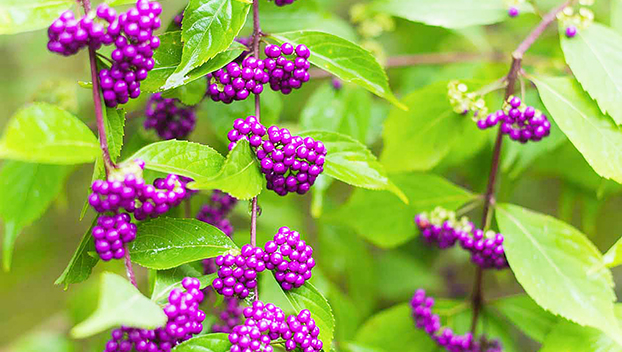CERTIFIED TEXAS EXPERT GARDENER — Garden with ease by using perennials, nativars and Texas SuperStar
Published 12:02 am Wednesday, June 5, 2024

- American beautyberry (Callicarpa americana) is an amazing nativar (native perennial) shrub that grows up to 8 feet tall and nearly as wide that can thrive in shady areas. (gardenerspath.com)
|
Getting your Trinity Audio player ready...
|
What a difference a year makes! Last year our Spring weather patterns provided significantly less rainfall with dramatic summer effects.
Local municipality Public Water Systems (PWS) have drought contingency plans, which were enacted, initially requesting customers voluntarily reduce water consumption. The PWS limited landscape irrigation to a couple days per week, from late evening until morning hours (8pm until 10am) to limit evaporative loss during mid-day hours.
We experienced a blistering summer and an extreme drought last year forcing PWS to move past voluntary water restrictions to stricter, mandatory phases which restricted washing vehicles, filling pools, further tightening landscape irrigation or face penalties.
Several areas, including Beaumont and Nederland experienced water main ruptures which forced some customers to boil water before use, while others did not have water until water lines were repaired. The ruptures were directly attributable to excessive heat and minute traces of rainfall.
We are receiving significant amounts of rainfall this spring, let’s hope the showers continue! Summer is close at hand beginning June 20, according to the Farmer’s Almanac. Rainy days (not severe weather) provides gardeners a respite- a chance to slow down a bit-to rest.
Time outdoors (gardening) is highly enjoyable for gardeners but now and then we need to recharge and restore work-life balance. Let’s discuss how to make gardening easier and more effective through plant selection.
Plant categories can sometimes become complicated but there are three groups: Perennials, Nativars (Natives), and Texas SuperStar® this gardener typically groups into one “extended” category for ease of selection as they have similar characteristics.
Texas SuperStar® plants have been rigorously tested by Texas A&M AgriLife and horticultural groups to determine if they qualify to be called Texas Superstars®. Plants are monitored for several years (at numerous TX locations) observing performance in specific landscapes. If the plant performs well around the state, it could be selected, then added to the Texas SuperStar® list. The list includes annuals, perennials, trees, woody shrubs, and specialty plants. Some of the most popular Texas SuperStar® plants are the Texas Bluebonnet, Plumbago, Laura Bush Petunia, Mexican Bush Sage, Belinda’s Dream Rose and Deciduous Holly. For a complete list of the Texas SuperStar® plants, visit the Texas SuperStar® website: https://texassuperstar.com/
Perennial plants live more than 2 years and span multiple plant types: shrub, tree, flower, grass, herbaceous, and vegetable. Horticulturalists sometimes refer to these plants, such as verbena, oregano, coneflower, and hardy hibiscus as herbaceous (herb) plants. However, there are some gardening books which refer to herbs meaning herbaceous plants, not to be confused with the herbs used in cooking.
Natives (nativars) are plants which are indigenous to a region. We have several native plants, such as the Cardinal Flower, Indian Pink, Southern Wood Fern, Black-eyed Susan, Milkweed, Texas Mountain Laurel, and there are numerous others! Nativars have characteristics like perennials, which return yearly. For more information regarding native Texas plants, visit the Native Plant Society of Texas website: https://npsot.org/wp/.
Most of the Texas SuperStars®, Perennials and Nativars are sun-loving plants, so choose planting locations carefully. Many are drought tolerant but require irrigation during extended periods of elevated temperature and during drought conditions. There are perennial choices to provide visual interest and blooms for every season including winter.
It’s important to take time and plan your garden, noting where plants are to be placed, ensuring taller plants are to the back with shorter plants in front for visibility. I highly recommend learning the characteristics of each plant by reading about them before placing them in the soil, while making certain to allow optimal spacing between plants.
Learn from my past and recent gardening mistakes, such as when I planted an American Beautyberry shrub at the front of a flower bed (last year). It grew into a large shrub (5-feet tall and wide), outgrowing and hiding numerous other plants. Naturally, I planned to relocate the shrub this spring and then forgot. It will take over the flower bed again, growing even larger!
Keep acid-loving plants grouped together to allow the required pH level to be easily maintained higher than other plants. It’s easier, requiring less time and energy to adjust pH for an area rather adjusting pH levels for individual plants.
Winter preparation is simple, simply add a 2-inch layer of both compost and mulch. The compost provides nutrients while keeping roots warm, and mulch will maintain heat during winter. Be patient in spring, since it will take time for new growth to appear.
Once plants begin growing in spring, a robust and healthy plant will provide you with exceptional visual displays! There is often an added benefit as many of these plants attract pollinators: bees, butterflies, and hummingbirds. Organic gardening allows other wildlife to enjoy the bounty your plants provide.
After selecting plants for your garden, water daily until established. Fertilize plants meeting their requirements. These plants will be growing in their chosen spot for many years and will thrive if provided a nurturing head start.” Deadheading and pruning perennials are important tasks and part of their care. Prune perennials as needed, immediately after blooming is complete.
Remember if you wait to prune, next year’s blooms may suffer! Some perennials have a flush of blooms in the spring followed, if pruned will provide 2nd flush later in the summer. Check bloom time and learn about the correct pruning time for each selected plant.
Send Certified Texas Expert Gardener John Green your questions and please continue sending comments to jongreene57@gmail.com.





